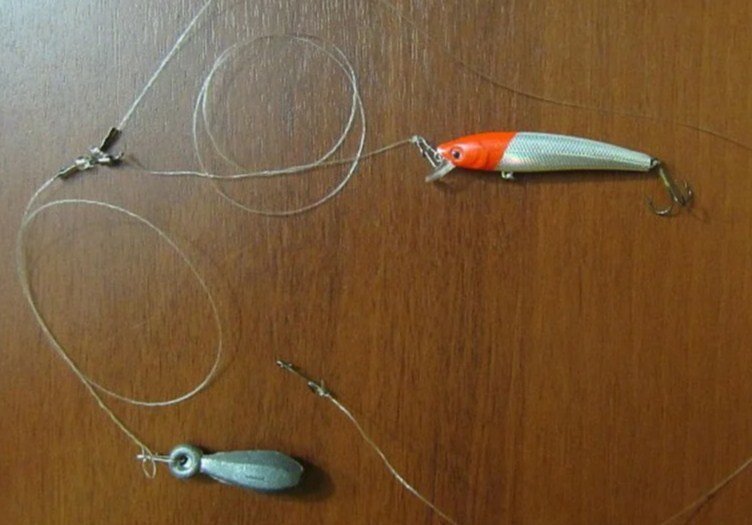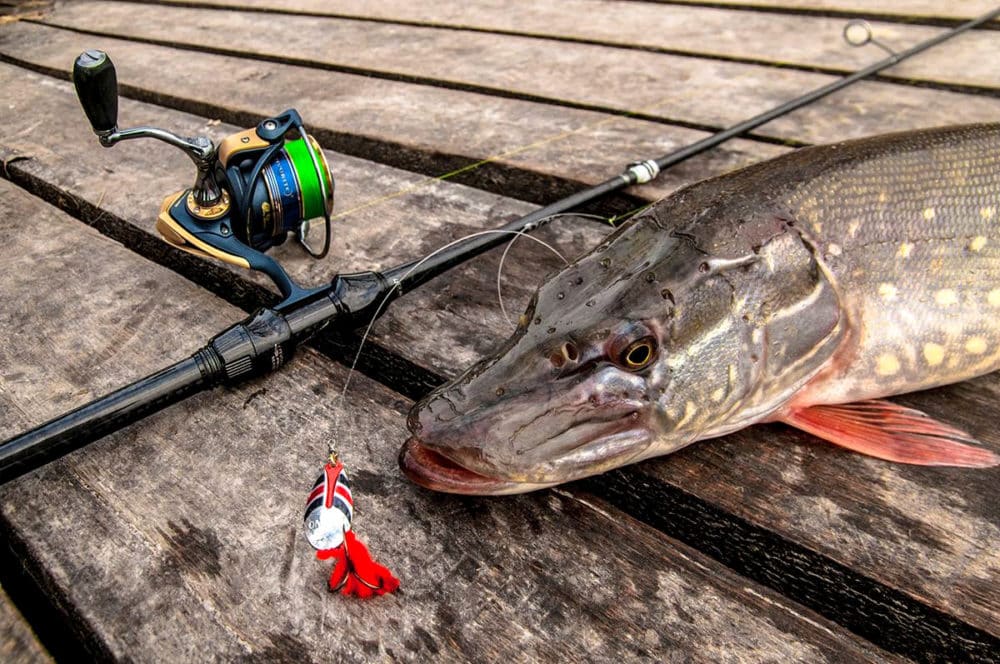The diverter leash , as one of the types of spaced spinning assemblies, has been used by domestic and foreign fishermen for quite a long time and everywhere. But most often, a jig bait is placed on the diverter (aka Moscow rig), but a wobbler is several times less common. Let’s figure out the specifics of fishing with a diverter leash with a wobbler. We also note what types of installation should be used, let’s pay attention to how exactly it is worth catching pike perch, pike and perch on a diverter lead in conjunction with a wobbler and when.
Moscow rig is a classic spaced spinning rig, where the sinker and bait are attached on different leashes of various lengths and diameters. The bait is on a longer leash, but closer to the tip of the rod, and the bullet weight is at the dead end of the entire tackle on a short leash.
- When it makes sense to put a wobbler on a lead-off leash – the pros and cons of installation
- Mounting a wobbler on a lead-in: how to tie a bait
- What wobblers are used for Moscow rig
- Catching with a wobbler on a diverting leash by casting – who, where and how
- How to work a diverter with a pike wobbler
- Catching zander with a wobbler on a lead
- How to use a diverter lead with a perch wobbler
- Trolling on a drop lead with a wobbler: selection, feeding, wiring
- Tackle used
- Поделиться ссылкой:
When it makes sense to put a wobbler on a lead-off leash – the pros and cons of installation
Schematically, the installation looks like this:
- The spinning player wants to expand the area of application of wobblers – in some cases, the most successful and catchy lures from the entire possible arsenal that is available. It is the diverter that allows you to fish with small wobblers at great depths and long distances, without losing critical lures in the game.
- Even a small weight allows you to cast a sailing wobbler in windy weather .
- It is possible to painlessly change the working depth of the wobbler set by the manufacturer . Let’s say that a certain minnuck works in the horizon of 1.5-2 meters, but it needs to be driven to 4. This is where the Moscow rig will come in handy.
- On the current, the wobbler does not squeeze out to a depth and, if the weight of the load is selected correctly, it literally combs the bottom without separation, walking in the working horizon, which is especially important when fishing for pike perch and large perch, which can stand on a rather strong current at the very bottom.
- In certain circumstances, a wobbler on a diverter is more attractive to predatory fish than a jig, due to the fact that it emits a strong vibration. These are, for example, flood conditions, when the water is cloudy, on muddy lakes, at dusk and at night.
From here we can conclude when it is worth using wobblers in conjunction with the Moscow one. This is the need for long-distance casting of a shallow wobbler, the need to conduct almost any wobbler (not only a diver) at medium / great depths, especially if such conditions are combined with the fact that it is not possible to attract a predator to other lures – summer complete passivity, spring fishing in muddy water, or in low light at dawn.
Of the minuses, the following should be noted – due to some clutter and oversupply of equipment, wobbler tees often cling to a leash with a load or the main line. To avoid this, we recommend using long bait leads, remove the rear tee and, of course, use a casting technique – it should be whipping and sharp.
Mounting a wobbler on a lead-in: how to tie a bait
To equip the Moscow rig, you must have in your arsenal:
- stick weights or the like;
- fluorocarbon;
- swivels;
- clasps;
- wobblers;
- spinning tackle;
- some knowledge and desire.
Installation when using a wobbler is practically no different from that which is used when equipping with a jig bait. There are several options: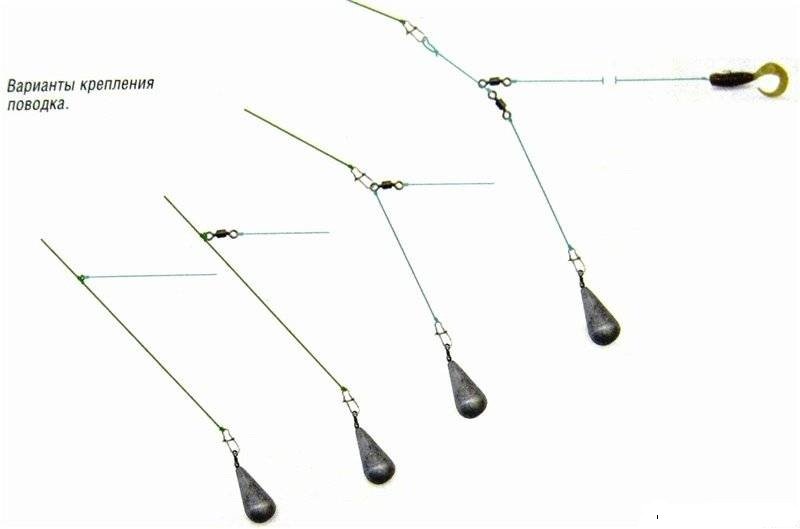
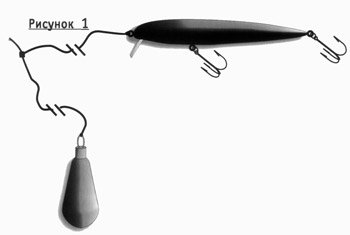
Elongated sinkers are used – olive, ballerina, banana, pear, Tyrolean stick, bullet, less often eared sinker.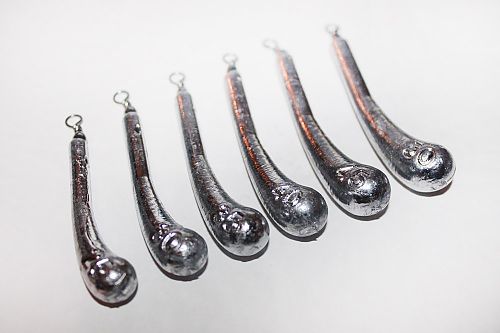
Further, these leashes are attached to each other and the main fishing line using one of the methods in the photo (in detail and in detail about the installation and not onlyhere and
here ). The installation of a branch leader is simple and difficult – there are two ways: https://youtu.be/6-o2SEQ_F7Q Thus, all the equipment is one whole, but at the same time, spaced apart in space. If you use a wobbler on a retraction leash even when hunting for pike, in most cases we do not recommend using leash materials, let alone elastic twists. Since such a leash can greatly affect the game of the wobbler. When fishing for pike with medium and large wobblers, especially minnow, we use only 0.35-0.5 mm flux. The following situations can be recorded as exceptions:
- The pike’s zeal is excellent, there are trophy specimens, which are not a hindrance to fluor . Then you can and should put the leash material. Or maybe just switch to a different fishing method, if everything is so good, nevertheless, the diverter-wobbler bundle is more about passive fish, when you need to get away from zero, and not about purposeful fishing for an active predator.
- Used massive rolls , deep shads , which are not a hindrance to a leash in the game.
- If the leash is the most delicate, and the wobbler is pop-up, but a suspender or sinker is needed . In this case, the leash may be for the good.
When fishing for pike perch and perch, we use a fluor with a diameter of 0.2-0.35 mm.
In such cases, you can use the following type of installation: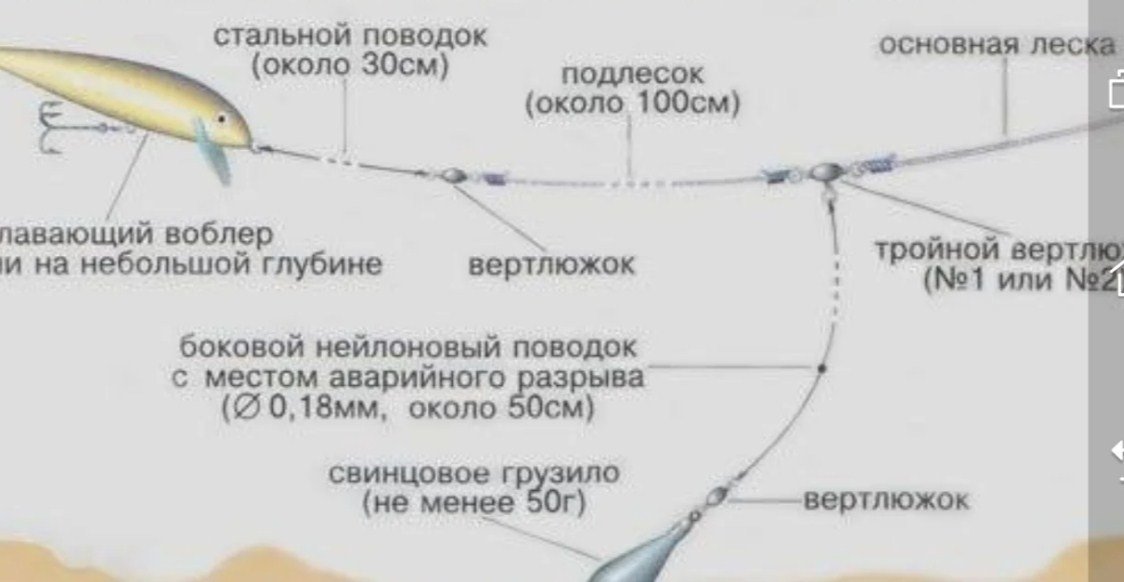
What wobblers are used for Moscow rig
Floating wobblers and suspender wobblers are used. Size and type (minnow, shad, fat) – depending on the purpose of fishing, the size of the predator and its activity. General tips when choosing a wobbler:
- No matter how good the diverter is, it’s not worth insanely shallowing with a wobbler . We will leave the little ones to ultralight . The size of lures for perch is 3-6 cm (minnows and cranks), for zander 4-8 cm (usually minnows and shads), for pike 5-10 cm (the whole set of forms and types).
- The wobbler should hold the flow well, complex and aggressive animation .
- It is highly desirable that there is a confident and attractive pause play , if with a slow emergence, it is gorgeous.
- It is worth using on a diverting leash those models of wobblers that are not applicable at regular casting due to the situations listed above .
- Do not use very expensive wobblers from top manufacturers . In any case, the diverter in combination with a wobbler is not the most passable tackle, and fishing is often carried out in difficult places. Therefore, there will be cliffs and so that it is not excruciatingly painful, we use the middle price range – Aiko, Spro, Pantun 21, Stayk Pro, Kosadaka, Salma, Tsuribito, etc. They produce relatively inexpensive but high quality baits in a wide range. Cheap Chinese do not meet the following criteria:
- They do not have their own game at slow speeds and roll on their side – which is especially critical when fishing for pike, medium and large perch, passive zander in the current.
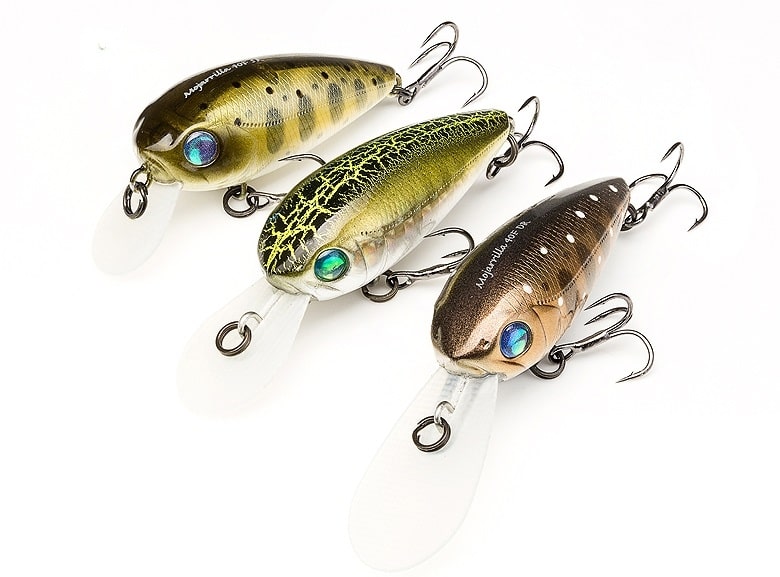
here… Minnows are more finicky.Of specific models, it is worth noting Strike Pro arc minnow, Kosadaka Mirage, Kosadaka Intra, Kosadaka Ion, Tsuribito Dead minnow and many others – often those that are already in the box. Size range from 4 to 12 cm. For perch 4-6, pike perch up to 8-10 cm, for pike up to 12, and sometimes more. Smaller in spring, largest in autumn. The colors are selected based on the same considerations as for conventional wobbler fishing. A wider choice of a specific model always lies with the angler, it is very extensive and varied, but our recommendations for choosing the best wobblers for
pike can be studied at the link.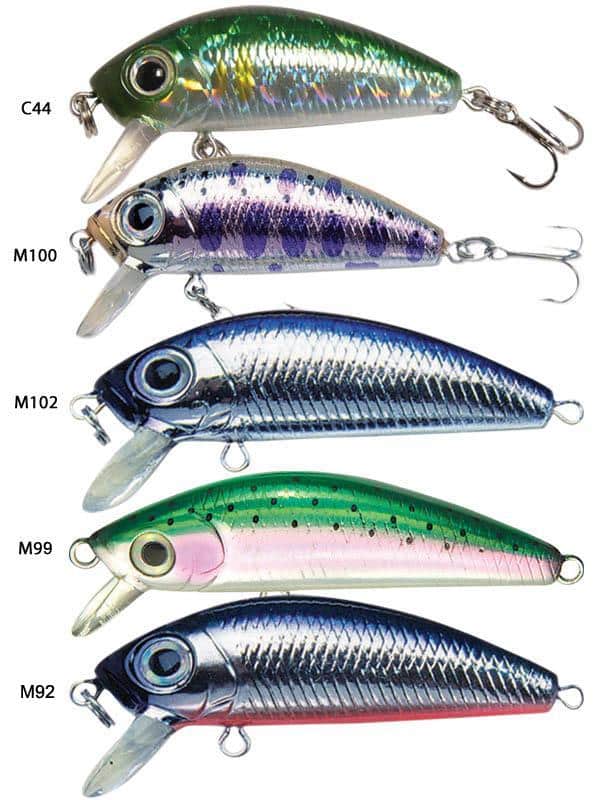
Catching with a wobbler on a diverting leash by casting – who, where and how
Read more about fishing with diverter
pike ,
perch and
pike perch on the links, in the context of this article we will go through the peculiarities of catching these predators with Moscow rigs in alliance with wobblers. It should be understood that the Moscow rig with a wobbler is the last echelon, the last chance to get away from zero and seduce a stubborn and passive predator. Where the pressure of anglers is off scale, or on days when the weather is not favorable at all. In other situations, it is worth trying just wobblers, jig or diverter with jig lures.
How to work a diverter with a pike wobbler
We have already mentioned the peculiarities of mounting the rig on the pike in the section above. Here we note such a nuance that the pike is more often than other fish in the snag and other “strong” places, and therefore it will be appropriate to use oblong weights that will knit on a thinner fishing line than the bait leash, so as not to lose all the tackle when hooked.
It is also worth replacing the hooks of wobblers no thinner from Ovner, which bend with powerful tackle, but do not break, plus they cut through the mouth of a toothed beast well.
The pike loves to keep to deep places – edges, pits and exits from them, and on reservoirs and large lakes it often stands at the bottom or in the immediate vicinity of it.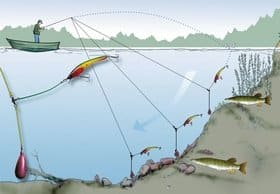
pure jig step .
This is how often you need to work on the pike! The step is jigging and aggressive, with a high separation from the bottom with twitching in combination – only the Moscow rig is capable of this.
The used size is from 5 to 10 cm – the most common. The pike often stands at the very bottom, in such cases a variation of the diverter leash, the so-called Tyrolean stick, is good. A variant of the rigging on a Tyrolean stick, when wiring is needed at the very bottom: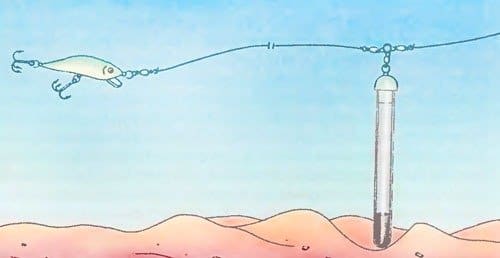
Catching zander with a wobbler on a lead
If you are fishing for pike perch on a clean, hard bottom, without a special snag, then we will not recommend replacing the hooks with softer ones, as when fishing for pike on snagged edges and pits, we will not. Since it is possible to pierce a fanged hard mouth only with sharp and hard hooks, especially if fishing is carried out at a long distance. The pike perch often chooses the deepest places available in its habitat and keeps at the very bottom. It is with the aim of finishing it off, using a wobbler, that a loaded diverter leash is used, in view of the fact that even deep-water wobblers, divers will not take a depth of more than 5-6 meters, and the tackle is needed for them appropriate – very powerful, but at the same time sensitive. Then, when fishing for pike perch at a depth, it is worth using suspenders with a powerful shovel and loading with a diverter leash with a load of 20-40 grams, depending on the depth and nature of the bottom.A diverter lead with a wobbler often helps out on passive pike perch, which squeezes to the bottom at great depths when the jig is silent, and in the usual way the wobbler cannot be driven to a given horizon. Another situation in which it is appropriate to use the Moscow one, when the wiring is carried out against the current, and a wobbler with a small blade, which has a small angle of attack of 70-90 degrees. This will be squeezed out to the surface, which will not make it possible to make normal working wiring. On how to catch a pike perch on a diverter lead (not for wobblers, but the basics of application are not particularly different): https://youtu.be/yIhdi2aDM7cwhen wiring is made against the current, and a wobbler with a small blade, which has a small angle of attack of 70-90 degrees. This will be squeezed out to the surface, which will not make it possible to make normal working wiring. On how to catch a pike perch on a diverter lead (not for wobblers, but the basics of application are not particularly different): https://youtu.be/yIhdi2aDM7cwhen wiring is made against the current, and a wobbler with a small blade, which has a small angle of attack of 70-90 degrees. This will be squeezed out to the surface, which will not make it possible to make normal working wiring. On how to catch a pike perch on a diverter leash (not for wobblers, but the basics of application are not particularly different): https://youtu.be/yIhdi2aDM7c
How to use a diverter lead with a perch wobbler
For perch, the whole range of both used baits and types of wiring is possible. It all depends on where it stands at the moment, at what depth, what is its size. Learn more about
how to catch a perch on a reel in general. The more active the sailor is, the more aggressive the wiring should be. I like the perch very much the uniform wiring of the pot-bellied rolls with small pauses. You can try to seduce the predator with broaches of the rolls at the bottom. Often bites happen in the active phase of the animation. Minnow classically tweaks, there is no particular difference in comparison with the classic twitch minnows for perch.
Note that the minnow catches a larger perch and is more passive than the rolls. From this, a practical advice when fishing for perch on a lead leash with a wobbler is to use cranks on an active perch at regular intervals with pauses, on a passive minnow with various types of twitching and other animations.
It is interesting to catch small and medium-sized perch on microbloblers with a diverter lead, this allows, firstly, to tolerate far to throw a small and light bait, and secondly, then drive it to at least some depth. This is especially important if there is no ultralight tackle, and the situation dictates the need to use the smallest wobblers weighing 2-3 grams. https://youtu.be/FKCOH05fVWs
Trolling on a drop lead with a wobbler: selection, feeding, wiring
In trolling, it is extremely important to keep the bait, in our case a wobbler, in a given wiring horizon. For this purpose, avid trollers use expensive and complex devices – riggers, bouncers, sinkers, and so on.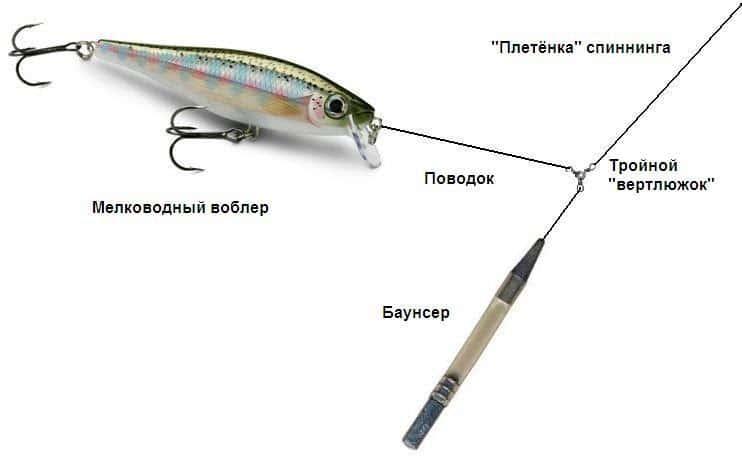
For example, Scotty’s downrigger costs 15,000-20,000 rubles, and a snap-on attachment in the classic form, or in the form of a clip, will cost 50-200 rubles.
But what if the conditions dictate the use of trolling, and there is a boat with tackle at hand? In this case, you can use a diverter with a wobbler.
If there are deep-sea divers in the arsenal, and the depth of fishing does not exceed their working horizon, then the use of a load does not make sense. But more often places where trolling is possible in principle have a depth of 5 meters or more, and wobblers with such a depth are only a few, and not all of them have them in boxes. It is also worth considering that if it is necessary to use a catchy wobbler with a small blade on the current, then in any case it will be squeezed out to the surface without additional loading.
Another option for a purely trolling branch lead with a wobbler is a cargo clip: https://youtu.be/qUOcWXKkmzE .be / 0hjx47LANEs
Tackle used
When fishing on a diverter with a wobbler, it is worth using a promiscuous and sonorous blank, fast action.
The test is selected based on the fishing conditions = required weight of the sinker + weight of the wobbler + stock of 20 percent. Example of calculation. It is planned to fish at a depth of 6 meters with a slow current at a distance of 30-40 meters. Sufficient load in such conditions is in the region of 14-16 grams. Plus a roll weighing 8 grams. Total 22-24 grams. With a margin, this is a rod with a test of 15-35 grams. Along the line – either braid, but with a fluor shock leader to avoid wear of the braid against an aggressive environment (sand, stones, branches), or fluor as a base completely. Mono-line will not work in most cases – weak for wear, not as sensitive as a cord – does not convey animation, bite, sweep clearly enough. A rather long spinning rod is required, since the overhang of the bait leash can be quite large. Let’s just say the optimal length is 2.2-2.5 meters. Braid reel – non-spinning according to Shimano 2000-2500 with perfect cord laying and no loosening of loops on twitching. Otherwise, fishing will turn from pleasure to hell. It is better to use a multiplier reel with fluorocarbon, it is this reel that works better with fluor 0.2-0.5 diameters. Is there a prospect for the Moscow rig in combination with a wobbler? Undoubtedly. It is important to understandin what conditions it is worth using this equipment. A diverter with a wobbler is a rig for local spot fishing of promising places, especially in combination with the passivity of a predator. For an active predator, it is better to use methods that allow you to more quickly identify feeding fish in a wide area. In such a situation, we use jig, spinners, ordinary wobblers. It’s nice to try, evaluate and understand something new and not the most popular. Fishing with a wobbler, which is loaded with a weight, but on a spaced leash, is just such a case. Try it, you won’t regret it.In such a situation, we use jig, spinners, ordinary wobblers. It’s nice to try, evaluate and understand something new and not the most popular. Fishing with a wobbler, which is loaded with a weight, but on a spaced leash, is just such a case. Try it, you won’t regret it.In such a situation, we use jig, spinners, ordinary wobblers. It’s nice to try, evaluate and understand something new and not the most popular. Fishing with a wobbler, which is loaded with a weight, but on a spaced leash, is just such a case. Try it, you won’t regret it.
